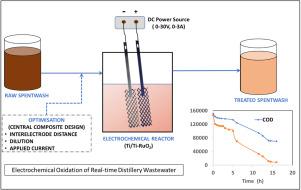Environmental Technology & Innovation ( IF 6.7 ) Pub Date : 2020-09-24 , DOI: 10.1016/j.eti.2020.101181 Inigo Johnson , Mathava Kumar

|
In this study, distillery wastewater (DWW) treatment was attempted via an electrochemical reactor (Cathode: Titanium and Anode: Ruthenium-oxide coated titanium (Ti-RuO2)) without the addition of external electrolytes. As a first step, the central composite design (CCD) experiments were carried out to investigate the effects of applied electric current (0.5-2 A), dilution of DWW (10-30 times) and inter-electrode distance (0.5-2 cm) on COD removal and energy yield from DWW. The CCD experiments revealed that lower current density with a lesser inter-electrode distance and least dilution conditions were suitable to improve the energy efficiency for COD removal. Subsequently, the raw DWW was treated at a current of 0.5A and an inter-electrode distance of 0.5 cm to increase energy yield. After 14 h of electrochemical treatment, 52% COD and 92.4% colour were removed from the DWW. Under this condition, the energy yield of reactor was found to be 177.4 mg COD/Wh with a specific current consumption of 1.48 Ah/g COD. Moreover, the BOD/COD ratio of treated raw DWW was increased from 0.25 to 0.57, which shows that electrochemical oxidation could be adopted as a pre-treatment before biological DWW treatement. Although the energy requirement for electrochemical treatment was high, it could reduce the footprint of wastewater treatment plant and better management of DWW.
中文翻译:

尺寸稳定的Ti-RuO 2阳极对酿酒废水的电化学氧化
在这项研究中,尝试通过电化学反应器(阴极:钛和阳极:氧化钌涂层钛(Ti-RuO 2)),而无需添加外部电解质。第一步,进行中央复合设计(CCD)实验,以研究施加电流(0.5-2 A),DWW稀释(10-30倍)和电极间距离(0.5-2 cm)的影响)去除DWW的COD和能源产量。CCD实验表明,较低的电流密度,较短的电极间距离和最小的稀释条件适合提高去除COD的能量效率。随后,以0.5A的电流和0.5 cm的电极间距离处理原始DWW,以提高能量产量。电化学处理14小时后,从DWW中去除了52%的COD和92.4%的颜色。在此条件下,发现反应器的能量产量为177.4 mg COD / Wh,比电流消耗为1.48 Ah / g COD。此外,处理过的原始DWW的BOD / COD比从0.25增加到0.57,这表明电化学氧化可以作为生物DWW处理之前的预处理。尽管电化学处理的能源需求很高,但它可以减少废水处理厂的占地面积并更好地管理DWW。











































 京公网安备 11010802027423号
京公网安备 11010802027423号